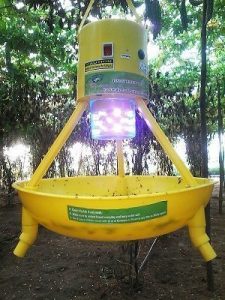- The natural enemies of pests are other organisms (fungi, bacteria, viruses, insect predators and insect parasitoids) which kill pest.
- Minimize the application of chemical pesticides.
- Allow some pests to live in the field which will serve as food or host for natural enemies.
- Establish a diverse cropping system (e.g. mixed cropping).
- Include host plants providing food or shelter for natural enemies (e.g. flowers which adult beneficial insects feed on).


- Light traps can be used to catch moths such as armyworms, cutworms, stem borers and other night flying insects.
- Colour and water traps can be used to monitor adult thrips.
- Yellow sticky traps can be used to control whiteflies, aphids and leaf mining flies.

Neem solution – Deters and kills many species of caterpillars, thrips and whitefly.
- Crush handful of seeds to a coarse powder or bruise 1 kg of leaves to make a concentrate.
- Infuse them 15 minutes in hot water or over night in cold water.
- Working under shade, filter thr concentrate into a half filled tank. Stir in a little soap powder and top up the tank clean cold water.
- Spray the crop in the late afternoon because neem breaks down in the sunlight.
Chillipepper
- Chillies and capsicum pepper have both repellent and insecticidal effects.
- To make the chilli extract grind 200 g of chillies into a fine dust.
- Boil it in 4 litres water.
- Add another 4 litres of water and a few drops of liquid soap.
- This mixture can be sprayed against aphids, ants, small caterpillars and snails.
Neemastra – Controls sucking pests and mealy bugs
- Mix 10 liters of Cow urine with 200 liters of water.
- Add 10 Kg of Cow dung to the mixture.
- Crush 10 Kg of Neem Leaves and add to the mixture.
- Allow this solution to ferment for 24 hours.
- Stir the mixture twice a day by using a wooden stick.
- After that filter the solution using a cloth and use it.
Weeds can be considered a significant problem because they tend to decrease crop yields by increasing competition for water, sunlight and nutrients while serving as host plants for pests and diseases.
It has been found that in some cases herbicides use can cause some weed species to dominate fields because the weeds develop resistance to herbicides.
Critical weed-free period for Horticultural Crops
Crop | Critical Weed-free Period |
Beets | 2-4 weeks after emergence |
Cabbage | 3 weeks after planting |
Carrots | 3-6 weeks after emergence |
Cucumbers | 4 weeks after seeding |
Lettuce | 3 weeks after planting |
Onions | The whole season |
Potatoes | 4 weeks after planting |
Strawberries | During May and June |
Weed Management Methods
Cultural Method
- Crop rotation – Crop rotation involves alternating different crops in a systematic sequence on the same land. When diverse crops are used in a rotation, weed germination and growth cycles are disrupted by variations in cultural practices associated with each crop (tillage, planting dates, crop competition, etc).
- Cover crops – Rapid development and dense ground covering by the crop will suppress weeds.
- Intercropping – Intercropping involves growing a crop between rows of the main crop. Intercrops are able to suppress weeds.
- Mulching – Mulching or covering the soil surface can prevent weed seed germination by blocking light transmission preventing seed germination. Straw, bark, and composted material can provide effective weed control.
Mechanical Weed Control
Mechanical removal of weeds is both time consuming and labor-intensive but is the most effective method for managing weeds. Mechanical weeders include cultivating tools such as hoes, harrows and brush weeders and dual-purpose implements like thistle-bars. The brush weeder is mainly used for vegetables such as carrots, beetroot, onions, garlic, celery and leeks.
Thermal Weed Control
Soil solarization
During summer and fall, organic farmers sterilize their soil through solarization. In this process, a clear plastic film is placed over an area after it has been tilled and tightly sealed at the edges. Solarization works when the heat crated under the plastic film becomes intense enough to kill weed seeds.

